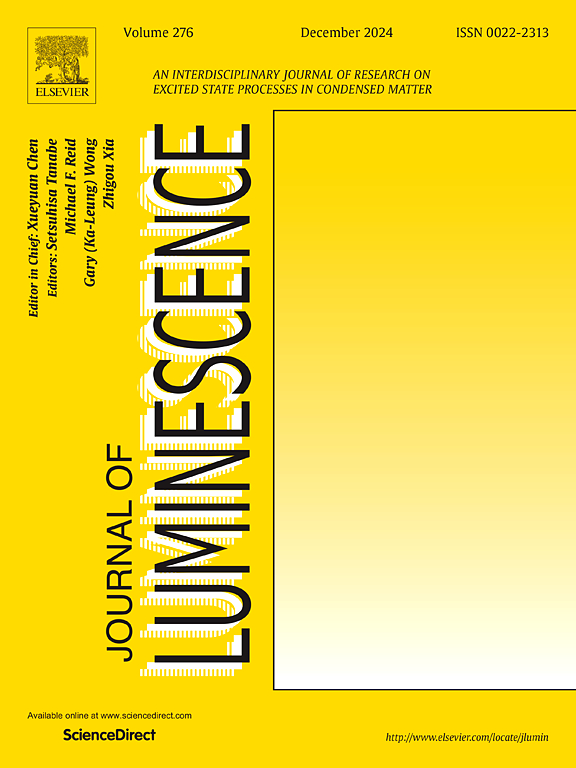A novel Er3+ activated Y4Al2O9 nanophosphors with high thermal stability for applications in w-LEDs and latent fingerprints detection
IF 3.3
3区 物理与天体物理
Q2 OPTICS
引用次数: 0
Abstract
A series of un-doped and 1–9 mol % Er3+ doped Y4Al2O9 nanophosphors (YAO:Er3+ NPs) are synthesized through a urea-assisted combustion process. X-ray diffraction (XRD) analysis confirmed the monoclinic structure for both types, while scanning electron microscopy revealed their irregular morphology. The YAO:Er3+ NPs exhibited an excitation peak at 380 nm, closely matching the near-ultraviolet (n-UV) chip. When excited by n-UV light, these NPs produced a narrow-band green emission with a dominant peak at 549 nm. The optimal Er3+ doping concentration in YAO is identified as 5 mol %. Additionally, YAO:5Er3+ NPs demonstrated a color purity (CP) of 87.4 % and a thermal stability of 91.3 % at 423 K (T0.5>473 K). The temperature-dependent photoluminescence (TDPL) emission spectra are recorded in the range of 323–473 K, and the fluorescence intensity ratio (FIR) technique is employed to evaluate the optical temperature sensing capabilities of YAO:5Er3+ NPs. The maximum absolute sensitivity (Sa) and relative sensitivity (Sᵣ) are found to be 38 × 10−3 K−1 and 1.33 % K−1. The internal quantum efficiency (IQE) of the YAO:5Er3+ NPs sample is found to be 83.3 %. The fabricated white light-emitting diodes (w-LEDs) demonstrates CIE coordinates of (0.3635, 0.3557), a high color rendering index (CRI) of Ra = 94, and a correlated color temperature (CCT) of 4361 K, achieved by incorporating the optimized YAO:5Er3+ green phosphor into w-LED devices. Furthermore, these NPs enhance the visualization of ridge patterns, minutiae points, and pore structures in latent fingerprints (LFPs), improving clarity for high-resolution forensic analysis. This study also explores YOLOv8x, an advanced object detection model, for LFPs analysis. Its state-of-the-art architecture enables fast, precise identification of key features, enhancing forensic investigations and biometric authentication. Experimental results show that YOLOv8x surpasses conventional methods in accuracy and speed, highlighting its superiority in fingerprint analysis. In conclusion, the YAO:Er3+ phosphors show great potential for applications in forensic analysis, optical temperature sensing, and w-LEDs.

一种新型Er3+活化Y4Al2O9纳米荧光粉,具有高热稳定性,应用于w- led和潜在指纹检测
采用尿素辅助燃烧法合成了一系列未掺杂和1 - 9mol % Er3+掺杂的Y4Al2O9纳米荧光粉(YAO:Er3+ NPs)。x射线衍射(XRD)分析证实了这两种类型的单斜斜结构,而扫描电镜显示它们的不规则形态。YAO:Er3+ NPs在380 nm处有一个激发峰,与近紫外(n-UV)芯片高度匹配。当被n-UV光激发时,这些NPs产生窄带绿色发射,其主导峰位于549 nm。在YAO中Er3+的最佳掺杂浓度为5 mol %。此外,YAO:5Er3+ NPs在423 K (T0.5>473 K)下的色纯度(CP)为87.4%,热稳定性为91.3%。在323 ~ 473 K范围内记录了温度依赖性光致发光(TDPL)发射光谱,并利用荧光强度比(FIR)技术评价了YAO:5Er3+ NPs的光学感温能力。最大绝对灵敏度(Sa)和相对灵敏度(Sᵣ)分别为38 × 10−3 K−1和1.33% K−1。发现YAO:5Er3+ NPs样品的内量子效率(IQE)为83.3%。通过将优化后的YAO:5Er3+绿色荧光粉掺入w-LED器件中,所制备的白光二极管(w-LED)的CIE坐标为(0.3635,0.3557),显色指数(CRI)为Ra = 94,相关色温(CCT)为4361 K。此外,这些NPs增强了潜在指纹(lfp)的脊纹模式、细部点和孔隙结构的可视化,提高了高分辨率法医分析的清晰度。本研究还探索了用于LFPs分析的先进目标检测模型YOLOv8x。其最先进的架构能够快速,精确地识别关键特征,增强法医调查和生物识别认证。实验结果表明,YOLOv8x在准确性和速度上都超过了传统的指纹分析方法,突出了其在指纹分析中的优势。综上所述,YAO:Er3+荧光粉在法医分析、光学温度传感和w- led方面具有巨大的应用潜力。
本文章由计算机程序翻译,如有差异,请以英文原文为准。
求助全文
约1分钟内获得全文
求助全文
来源期刊

Journal of Luminescence
物理-光学
CiteScore
6.70
自引率
13.90%
发文量
850
审稿时长
3.8 months
期刊介绍:
The purpose of the Journal of Luminescence is to provide a means of communication between scientists in different disciplines who share a common interest in the electronic excited states of molecular, ionic and covalent systems, whether crystalline, amorphous, or liquid.
We invite original papers and reviews on such subjects as: exciton and polariton dynamics, dynamics of localized excited states, energy and charge transport in ordered and disordered systems, radiative and non-radiative recombination, relaxation processes, vibronic interactions in electronic excited states, photochemistry in condensed systems, excited state resonance, double resonance, spin dynamics, selective excitation spectroscopy, hole burning, coherent processes in excited states, (e.g. coherent optical transients, photon echoes, transient gratings), multiphoton processes, optical bistability, photochromism, and new techniques for the study of excited states. This list is not intended to be exhaustive. Papers in the traditional areas of optical spectroscopy (absorption, MCD, luminescence, Raman scattering) are welcome. Papers on applications (phosphors, scintillators, electro- and cathodo-luminescence, radiography, bioimaging, solar energy, energy conversion, etc.) are also welcome if they present results of scientific, rather than only technological interest. However, papers containing purely theoretical results, not related to phenomena in the excited states, as well as papers using luminescence spectroscopy to perform routine analytical chemistry or biochemistry procedures, are outside the scope of the journal. Some exceptions will be possible at the discretion of the editors.
 求助内容:
求助内容: 应助结果提醒方式:
应助结果提醒方式:


